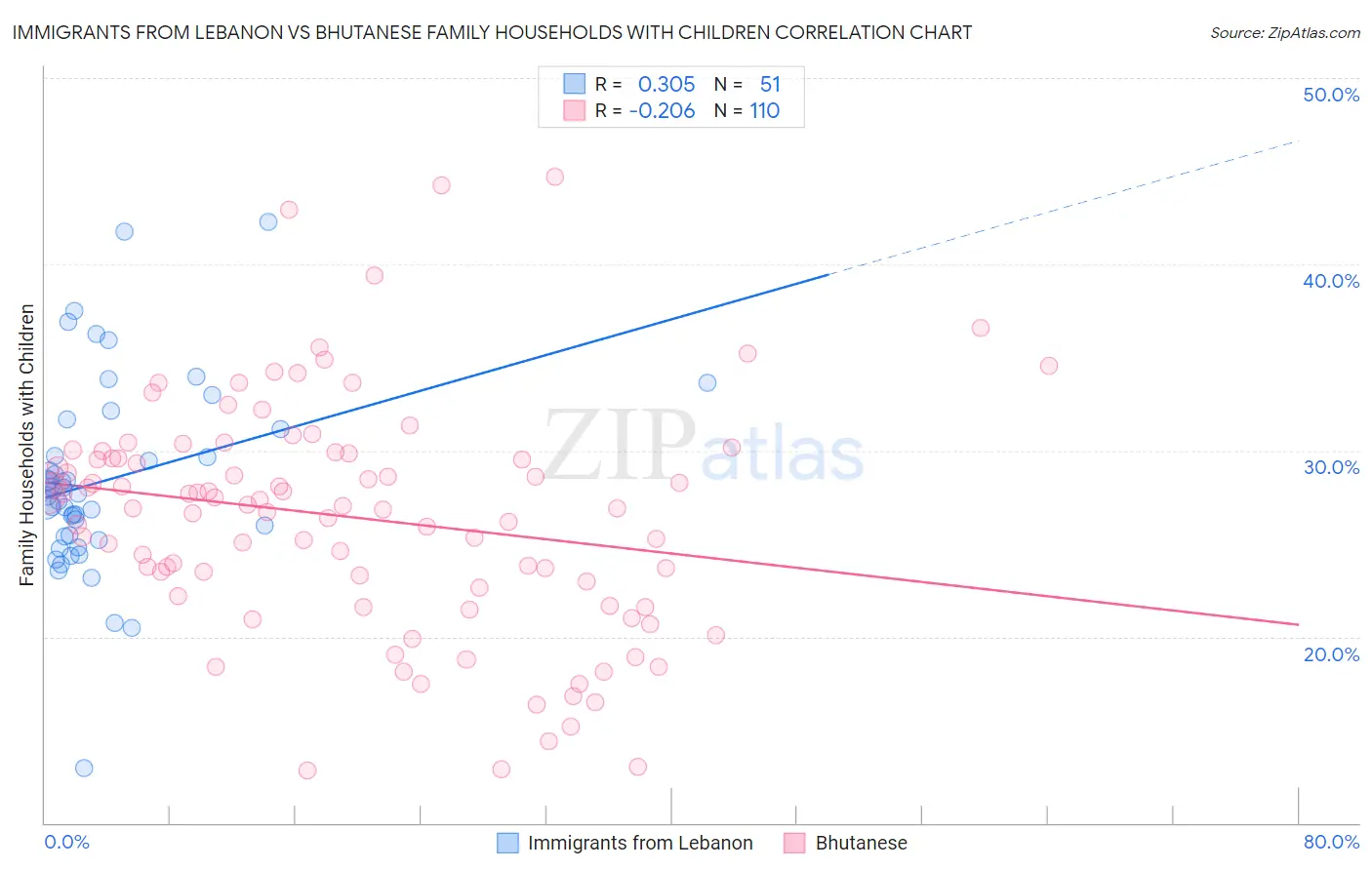Immigrants from Lebanon vs Bhutanese Family Households with Children
COMPARE
Immigrants from Lebanon
Bhutanese
Family Households with Children
Family Households with Children Comparison
Immigrants from Lebanon
Bhutanese
28.6%
FAMILY HOUSEHOLDS WITH CHILDREN
99.9/ 100
METRIC RATING
63rd/ 347
METRIC RANK
27.3%
FAMILY HOUSEHOLDS WITH CHILDREN
25.1/ 100
METRIC RATING
201st/ 347
METRIC RANK
Immigrants from Lebanon vs Bhutanese Family Households with Children Correlation Chart
The statistical analysis conducted on geographies consisting of 217,098,842 people shows a mild positive correlation between the proportion of Immigrants from Lebanon and percentage of family households with children in the United States with a correlation coefficient (R) of 0.305 and weighted average of 28.6%. Similarly, the statistical analysis conducted on geographies consisting of 454,969,293 people shows a weak negative correlation between the proportion of Bhutanese and percentage of family households with children in the United States with a correlation coefficient (R) of -0.206 and weighted average of 27.3%, a difference of 4.7%.

Family Households with Children Correlation Summary
| Measurement | Immigrants from Lebanon | Bhutanese |
| Minimum | 12.9% | 12.8% |
| Maximum | 42.3% | 44.7% |
| Range | 29.3% | 31.9% |
| Mean | 28.4% | 26.4% |
| Median | 27.7% | 27.0% |
| Interquartile 25% (IQ1) | 25.4% | 22.6% |
| Interquartile 75% (IQ3) | 31.2% | 29.8% |
| Interquartile Range (IQR) | 5.8% | 7.2% |
| Standard Deviation (Sample) | 5.2% | 6.3% |
| Standard Deviation (Population) | 5.2% | 6.2% |
Similar Demographics by Family Households with Children
Demographics Similar to Immigrants from Lebanon by Family Households with Children
In terms of family households with children, the demographic groups most similar to Immigrants from Lebanon are Immigrants from Ghana (28.6%, a difference of 0.010%), Egyptian (28.6%, a difference of 0.010%), Filipino (28.6%, a difference of 0.070%), Hmong (28.6%, a difference of 0.090%), and Immigrants from Nigeria (28.6%, a difference of 0.14%).
| Demographics | Rating | Rank | Family Households with Children |
| Immigrants | Guatemala | 100.0 /100 | #56 | Exceptional 28.8% |
| Danes | 100.0 /100 | #57 | Exceptional 28.7% |
| Hawaiians | 100.0 /100 | #58 | Exceptional 28.7% |
| Immigrants | Nigeria | 100.0 /100 | #59 | Exceptional 28.6% |
| Hmong | 99.9 /100 | #60 | Exceptional 28.6% |
| Immigrants | Ghana | 99.9 /100 | #61 | Exceptional 28.6% |
| Egyptians | 99.9 /100 | #62 | Exceptional 28.6% |
| Immigrants | Lebanon | 99.9 /100 | #63 | Exceptional 28.6% |
| Filipinos | 99.9 /100 | #64 | Exceptional 28.6% |
| Hondurans | 99.9 /100 | #65 | Exceptional 28.5% |
| Immigrants | Egypt | 99.9 /100 | #66 | Exceptional 28.5% |
| Ghanaians | 99.9 /100 | #67 | Exceptional 28.5% |
| Houma | 99.9 /100 | #68 | Exceptional 28.5% |
| Immigrants | Korea | 99.9 /100 | #69 | Exceptional 28.5% |
| Immigrants | Honduras | 99.9 /100 | #70 | Exceptional 28.5% |
Demographics Similar to Bhutanese by Family Households with Children
In terms of family households with children, the demographic groups most similar to Bhutanese are American (27.3%, a difference of 0.070%), Kiowa (27.3%, a difference of 0.090%), Immigrants from Congo (27.3%, a difference of 0.10%), Immigrants from Sudan (27.3%, a difference of 0.11%), and Immigrants from Haiti (27.2%, a difference of 0.15%).
| Demographics | Rating | Rank | Family Households with Children |
| Immigrants | Iran | 36.1 /100 | #194 | Fair 27.4% |
| Crow | 35.7 /100 | #195 | Fair 27.4% |
| Cheyenne | 35.1 /100 | #196 | Fair 27.4% |
| Norwegians | 35.0 /100 | #197 | Fair 27.4% |
| Immigrants | Romania | 34.4 /100 | #198 | Fair 27.4% |
| English | 32.0 /100 | #199 | Fair 27.3% |
| Immigrants | Congo | 28.7 /100 | #200 | Fair 27.3% |
| Bhutanese | 25.1 /100 | #201 | Fair 27.3% |
| Americans | 22.8 /100 | #202 | Fair 27.3% |
| Kiowa | 22.2 /100 | #203 | Fair 27.3% |
| Immigrants | Sudan | 21.6 /100 | #204 | Fair 27.3% |
| Immigrants | Haiti | 20.3 /100 | #205 | Fair 27.2% |
| Immigrants | Micronesia | 20.2 /100 | #206 | Fair 27.2% |
| Haitians | 19.8 /100 | #207 | Poor 27.2% |
| Immigrants | Poland | 16.4 /100 | #208 | Poor 27.2% |